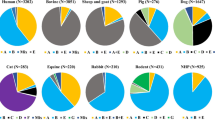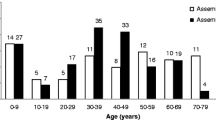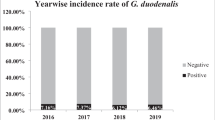Abstract
Giardia lamblia is a widespread flagellated parasite of mammalian species, including humans, and is regarded as the most common cause of protozoan diarrhea worldwide. Owing to its invariant morphology, investigation on aspects such as host specificity and transmission patterns requires a direct genetic characterization of cysts and trophozoites from host and environmental samples. A number of molecular assays have been developed to help unravel the complex epidemiology of this infection. A coherent picture has emerged from those studies, indicating the existence of seven genetic groups (or assemblages), two of which (A and B) are found in both humans and animals, whereas the remaining five (C-G) are relatively host-specific. With the rapid accumulation of sequence data and the refinement of the assays, the elucidation of many epidemiologic aspects seemed only a matter of time and proper study design. However, the occurrence of mixed infections, the allelic sequence heterozygosity between the nuclei, and the reported occurrence of several distinct recombinational events indicate a level of biological complexity that affects the molecular typing, particularly for assemblage B. Under these circumstances, caution must be applied in the interpretation of molecular data in epidemiology of giardiasis. A specific database for the storage and analysis of sequence and epidemiologic data has been recently developed, and represents an important tool for future studies.
Access this chapter
Tax calculation will be finalised at checkout
Purchases are for personal use only
Preview
Unable to display preview. Download preview PDF.
Similar content being viewed by others
References
Adam RD (2001) Biology of Giardia lamblia. Clin Microbiol Rev 14: 447–475
Ajjampur SS, Sankaran P, Kannan A, et al. (2009) Giardia duodenalis assemblages associated with diarrhea in children in South India identified by PCR-RFLP. Am J Trop Med Hyg 80: 16–19
Almeida AA, Pozio E, and Cacciò SM (2010) Genotyping of Giardia duodenalis cysts by new Real-Time PCR assays for detection of mixed infections in human samples. Appl Environ Microbiol 76: 1895–1201
Andrews RH, Adams M, Boreham PF, Mayrhofer G, and Meloni BP (1989) Giardia intestinalis: electrophoretic evidence for a species complex. Int J Parasitol 19: 183–190
Aydin AF, Besirbellioglu BA, Avci IY, Tanyuksel M, Araz E, and Pahsa A (2004) Classification of Giardia duodenalis parasites in Turkey into groups A and B using restriction fragment length polymorphism. Diagn Microbiol Infect Dis 50: 147–151
Baruch A, Isaac-Renton J, and Adam RD (1996) The molecular epidemiology of Giardia lamblia: a sequence-based approach. J Infect Dis 174: 233–236
Berrilli F, Di Cave D, D’Orazi C, et al. (2006) Prevalence and genotyping of human isolates of Giardia duodenalis from Albania. Parasitol Int 55: 295–297
Breathnach AS, McHugh TD, and Butcher PD (2010) Prevalence and clinical correlations of genetic subtypes of Giardia lamblia in an urban setting. Epidemiol Infect (In press)
Cacciò SM, Thompson RCA, McLauchlin J, and Smith H (2005) Unravelling cryptosporidfium and Giardia epidemiology. Trends Parasitol 21: 430–437
Cacciò SM and Ryan U (2008) Molecular epidemiology of giardiasis. Mol Biochem Parasitol 160: 75–80
Cacciò SM, Beck R, Lalle M, Marinculic A, and Pozio E (2008) Multilocus genotyping of Giardia duodenalis reveals striking differences between assemblages A and B. Int J Parasitol 38: 1523–1531
Cacciò SM, Sprong H (2010) Giardia duodenalis: genetic recombination and its implications for taxonomy and molecular epidemiology. Exp Parasitol 124: 107–112
Chute CG, Smith RP, and Baron JA (1987) Risk factors for endemic giardiasis. Am J Public Health 77: 585–587
Cooper MA and Adam RD, Worobey M, and Sterling CR (2007) Population genetics provides evidence for recombination in Giardia. Curr Biol 17: 1984–1988
de Wit MA, Koopmans MP, Kortbeek LM, Wannet WJ, Vinje J, van Leusden F, Bartelds AI, and van Duynhoven YT (2001a) Sensor, a population-based cohort study on gastroenteritis in the Netherlands: incidence and etiology. Am J Epidemiol 154: 666–674
de Wit MA, Koopmans MP, Kortbeek LM, van Leeuwen NJ, Bartelds AI, and van Duynhoven YT (2001b) Gastroenteritis in sentinel general practices, The Netherlands. Emerg Infect Dis 7: 82–91
Dib HH, Lu SQ, and Wen SF (2008) Prevalence of Giardia lamblia with or without diarrhea in South East, South East Asia and the Far East. Parasitol Res 103: 239–251
Dwivedi KK, Prasad G, Saini S, et al. (2007) Enteric opportunistic parasites among HIV infected individuals: associated risk factors and immune status. Jpn J Infect Dis 60: 76–81
Eisenberg JN, Brookhart MA, Rice G, Brown M, and Colford JM Jr (2002) Disease transmission models for public health decision making: analysis of epidemic and endemic conditions caused by waterborne pathogens. Environ Health Perspect 110: 783–790
Espelage W, an der Heiden M, Stark K, and Alpers K (2010) Prevalence and clinical correlations of genetic subtypes of Giardia lamblia in an urban setting. BMC Public Health (In press)
Farthing MJ, Mata L, Urrutia JJ, and Kronmal RA (1986) Natural history of Giardia infection of infants and children in rural Guatemala and its impact on physical growth. Am J Clin Nutr 43: 395–405
Faubert G (2000) Immune response to Giardia duodenalis. Clin Microbiol Rev 13: 35–54
Faustini A, Marinacci C, Fabrizi E, et al. (2006) The impact of the Catholic Jubilee in 2000 on infectious diseases. A case-control study of giardiasis, Rome, Italy 2000–2001. Epidemiol Infect 134: 649–658
Franzen O, Jerlström-Hultqvist J, Castro E, et al. (2009) Draft genome sequencing of Giardia intestinalis assemblage B isolate GS: is human giardiasis caused by two different species? PLOS Pathog (In press)
Gelanew T, Lalle M, Hailu A, Pozio E, and Cacciò SM (2007) Molecular characterization of human isolates of Giardia duodenalis from Ethiopia. Acta Trop 102: 92–99
Geurden T, Geldhof P, Levecke B, et al. (2007) Mixed Giardia duodenalis assemblage A and E infections in calves. Int J Parasitol 38: 259–264
Geurden T, Levecke B, Cacciò SM, et al. (2009) Multilocus genotyping of Cryptosporidium and Giardia in nonoutbreak related cases of diarrhoea in human patients in Belgium. Parasitology 136: 1161–1168
Haque R, Roy S, Kabir M, Stroup SE, Mondal D, and Houpt ER (2005) Giardia assemblage A infection and diarrhea in Bangladesh. J Infect Dis 192: 2171–2173
Haque R, Mondal D, Karim A, et al. (2009) Prospective casecontrol study of the association between common enteric protozoal parasites and diarrhea in Bangladesh. Clin Infect Dis 48: 1191–1197
Hollm-Delgado MG, Gilman RH, Bern C, Cabrera L, Sterling CR, Black RE, and Checkley W (2008) Lack of an adverse effect of Giardia intestinalis infection on the health of Peruvian children. Am J Epidemiol 168: 647–655
Homan WL and Mank TG (2001) Human giardiasis: genotype linked differences in clinical symptomatology. Int J Parasitol 31: 822–826
Hopkins RM, Meloni BP, Groth DM, Wetherall JD, Reynoldson JA, and Thompson RC (1997) Ribosomal RNA sequencing reveals differences between the genotypes of Giardia isolates recovered from humans and dogs living in the same locality. J Parasitol 83: 44–51
Hoque ME, Hope VT, Scragg R, Kjellström T, and Lay-Yee R (2001) Nappy handling and risk of giardiasis. Lancet 357: 1017–1018
Hoque E, Hope V, Scragg R, Baker M, and Shrestha R (2004) A descriptive epidemiology of giardiasis in New Zealand and gaps in surveillance data. N Z J Med 117: U1149
Hörman A, Korpela H, Sutinen J, Wedel H, and Hanninen ML (2004) Meta-analysis in assessment of the prevalence and annual incidence of Giardia spp. and Cryptosporidium spp. infections in humans in the Nordic countries. Int J Parasitol 34: 1337–1346
Kohli A, Bushen OY, Pinkerton RC, et al. (2008) Giardia duodenalis assemblage, clinical presentation and markers of intestinal inflammation in Brazilian children. Trans R Soc Trop Med Hyg 102: 718–725
Kosuwin R, Putaporntip C, Pattanawong U, and Jongwutiwes S (2010) Clonal diversity in Giardia duodenalis isolates from Thailand: evidences for intragenic recombination and purifying selection at the beta giardin locus. Gene 449: 1–8
Koulda J and Nohynkova E (1978) Flagellates of the human intestine and of intestines of other species. In: Protozoa of veterinary and medical interest 1978 (J.P. Kreier, ed.), New York, N.Y., Academic Press Inc., pp 69–104
Lalle M, Pozio E, Capelli G, Bruschi F, Crotti D, Cacciò SM (2005) Genetic heterogeneity at the β-giardin locus among human and animal isolates of Giardia duodenalis and identification of potentially zoonotic sub-genotypes. Int J Parasitol 35: 207–213
Lane S and Lloyd D (2002) Current trends in research into the waterborne parasite Giardia. Crit Rev Microbiol 28: 123–147
Lasek-Nesselquist E, Bogomolni AL, Gast RJ, et al. (2008) Molecular characterization of Giardia intestinalis haplotypes in marine animals: variation and zoonotic potential. Dis Aquat Organ 81: 39–51
Lasek-Nesselquist E, Welch DM, Thompson RC, Steuart RF, and Sogin ML (2009) Genetic exchange within and between assemblages of Giardia duodenalis. J Euk Microbiol 56: 504–518
Lebbad M, Ankarklev J, Tellez A, Leiva B, Andersson JO, and Svärd S (2008) Dominance of Giardia assemblage B in Leon, Nicarauga Acta Trop 106: 44–53
Logsdon JM Jr (2008) Evolutionary genetics: sex happens in Giardia. Curr Biol 18: R66–R68
Mahdy AK, Surin J, Mohd-Adnan A, Wan KL, and Lim YA (2009) Molecular characterization of Giardia duodenalis isolated from Semai Pahang Orang Asli (Peninsular Malaysia aborigines). Parasitology 136: 1237–1241
Mayrhofer G, Andrews RH, Ey PL, and Chilton NB (1995) Division of Giardia isolates from humans into two genetically distinct assemblages by electrophoretic analysis of enzymes encoded at 27 loci and comparison with Giardia muris. Parasitology 111: 11–17
Miller KM and Sterling CR (2007) Sensitivity of nested PCR in the detection of low numbers of Giardia lamblia cysts. Appl Environ Microbiol 73: 5949–5950
Monis PT, Andrews RH, Mayrhofer G, and Ey PL (1999) Molecular systematics of the parasitic protozoan Giardia intestinalis. Mol Biol Evol 16: 1135–1144
Monis PT, Andrews RH, Mayrhofer G, and Ey PL (2003) Genetic diversity within the morphological species Giardia intestinalis and its relationship to host origin. Infect Genet Evol 3: 29–38
Morrison HG, McArthur AG, Gillin FD, et al. (2007) Genomic minimalism in the early diverging intestinal parasite Giardia lamblia. Science 317: 1921–1926
Paintlia AS, Descoteaux S, Spencer B, et al. (1998) Giardia lamblia groups A and B among young adults in India. Clin Infect Dis 26: 190–191
Pelayo L, Nuñez FA, Rojas L, et al. (2008) Giardia infections in Cuban children: the genotypes circulating in a rural population. Ann Trop Med Parasitol 102: 585–595
Sahagun J, Clavel A, Goni P, et al. (2007) Correlation between the presence of symptoms and the Giardia duodenalis genotype. Eur J Clin Microbiol Infect Dis 27: 81–83
Savioli L, Smith H, and Thompson A (2006) Giardia and Cryptosporidfium join the “Neglected Diseases Initiative”. Trends Parasitol 22: 203–208
Smith H, Cacciò SM, Tait A, McLauchlin J, and Thompson RCA (2006) Tools for investigating the environmental transmission of Cryptosporidfium and Giardia infections in humans. Trends Parasitol 22: 160–167
Sprong H, Cacciò SM, and van der Giessen J (2009) Identification of zoonotic genotypes of Giatrdia duodenalis. PLOS Neg Trop Dis 3: e558
Stark D, Barratt JNL, van Hal S, Marriot D, Harkness J, and Ellis JT (2009) Clinical Significance of enteric protozoa in the immunosuppressed human population. Clin Microbiol Rev 22: 634–650
Stuart JM, Orr HJ, Warburton FG, et al. (2004) Risk Factors for sporadic giardiasis: a case-control study in Southwestern England. Emerg Infect Dis 9: 229–233
Sulaiman IM, Fayer R, Bern C, et al. (2003) Triosephosphate isomerase gene characterization and potential zoonotic transmission of Giardia duodenalis. Emerg Infect Dis 9: 1444–1452
Teodorovic S, Braverman JM, and Elmendorf HG (2007) Unusually low levels of genetic variation among Giardia lamblia isolates. Eukaryot Cell 6: 1421–1430
Thompson RC (2000) Giardiasis as a re-emerging infectious disease and its zoonotic potential. Int J Parasitol 30: 1259–1267
Traub RJ, Monis P, Robertson I, Irwin P, Mencke N, and Thompson RCA (2004) Epidemiological and molecular evidence support the zoonotic transmission of Giardia among humans and dogs living in the same community. Parasitology 128: 53–262
Traub RJ, Inpankaew T, Reid SA, et al. (2009) Transmission cycles of Giardia duodenalis in dogs and humans in Temple communities in Bangkok — a critical evaluation of its prevalence using three diagnostic tests in the field in the absence of a gold standard. Acta Trop 111: 125–132
WHO Expert Committee (1981) Intestinal protozoan and helminthic infections. WHO Tech Rep Ser 58: 666–671
WHO, The World Health Report (1996) Fighting Disease Fostering Development. World Health Organization, Geneva.
Wielinga CM and Thompson RC (2007) Comparative evaluation of Giardia duodenalis sequence data. Parasitology 134: 1795–1821
Yoder JS and Beach MJ (2007) Giardiasis surveillance — United States, 2003–2005. MMWR Surveill Summ 56: 11–18
Author information
Authors and Affiliations
Editor information
Editors and Affiliations
Rights and permissions
Copyright information
© 2011 Springer-Verlag/Wien
About this chapter
Cite this chapter
Cacciò, S.M., Sprong, H. (2011). Epidemiology of Giardiasis in Humans. In: Luján, H.D., Svärd, S. (eds) Giardia. Springer, Vienna. https://doi.org/10.1007/978-3-7091-0198-8_2
Download citation
DOI: https://doi.org/10.1007/978-3-7091-0198-8_2
Publisher Name: Springer, Vienna
Print ISBN: 978-3-7091-0197-1
Online ISBN: 978-3-7091-0198-8
eBook Packages: Biomedical and Life SciencesBiomedical and Life Sciences (R0)




